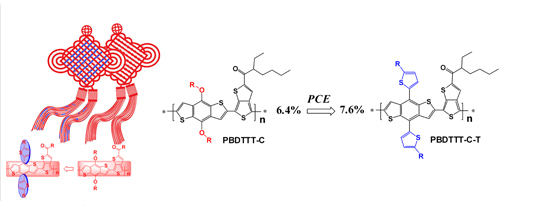Energy Conversion Efficiency of the Polymer Solar Cells in ICCAS Reached 7.6% by Two-Dimensional Conjugated Structure
Polymer solar cells (PSCs) have attracted much attention due to its potential application in flexible, light weight, and low cost large area devices through role-to-role printing. But the lower efficiency of PSCs still limited its further developments and applications.
In recent years, conjugated polymers based on benzo[1,2-b:4,5-b′]dithiophene (BDT) units have drawn great interests in PSCs as electron donors. For further improving photovoltaic performance of the conjugated polymers, structural modification by using different substituents on BDT or the copolymerized moieties is of great importance.
The researchers of State Key Laboratory of Polymer Physics and Chemistryand Key Laboratory of Organic Solids performed the studies on new BDT derivatives from last year.They designed and synthesized two new copolymers of the thiophene-substituted BDT with ester-substituted thieno[3,4-b]thiophene (TT-E) or carboxy-substituted thieno[3,4-b]thiophene (TT-C): PBDTTT-E-T and PBDTTT-C-T (see Fig 1). In comparison with the alkoxy-substituted polymers, the two-dimensional copolymers based on the thiophene-substituted BDT exhibit better thermal stability, higher hole mobility, deeper HOMO levels, significantly improved Voc and PCE for the PSCs with the polymers as donor. The best PSC device based on PBDTTT-C-T as donor and PC70BM as acceptor displayed a PCE of 7.6% with a Voc of 0.74 V and a Jsc of 17.5 mA/cm2.
The results indicate that PBDTTT-C-T is currently one of the best conjugated polymer donor for PSCs and the two-dimensional structure in the BDT-based copolymers is helpful to further improve their photovoltaic properties.The results have been published in Angew. Chem. Int. Ed.2011,50, 9697–9702.
The research was supported by the National Natural Science Foundation of China, f the Ministry of Science and Technology of China, Chinese Academy of Sciences and Institute of Chemistry, Chinese Academy of Sciences.

Fig 1 two-dimensional conjugated structures comprehensive improve its photovoltaic efficiency(Image by HUO Lijun).





